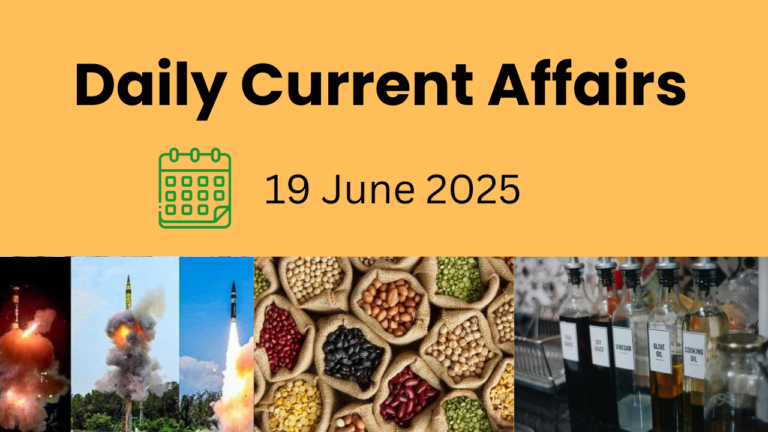1. Global Drought Outlook: A Growing Crisis Demanding Urgent Action
Context: A drought is a period marked by significantly below-average water availability, caused primarily by low rainfall. These dry spells are intensified by rising temperatures, strong winds, and increasingly by human activities that disrupt the natural water cycle.
There are three major types of drought:
- Meteorological Drought: Prolonged periods of reduced precipitation.
- Agricultural (Ecological) Drought: Insufficient soil moisture affecting crops and vegetation.
- Hydrological Drought: Declining water levels in rivers, lakes, and groundwater reserves over time.
Key Findings from the OECD Report:
The Organisation for Economic Co-operation and Development (OECD) has issued a stark warning in its latest Global Drought Outlook:
- The global area impacted by drought has doubled between 1900 and 2020.
- 40% of the Earth’s surface now experiences more frequent and intense droughts.
- Since 1980, 37% of global land has suffered a significant decline in soil moisture.
- 62% of monitored aquifers show falling groundwater levels, threatening long-term water security.
- Climate change made the 2022 European drought up to 20 times more likely. In North America, it increased drought probability by 42%.
Causes of Drought: A Dual Force of Nature and Human Activity
Natural Drivers:
- Climate variability (e.g., El Niño and La Niña) disrupts global rainfall patterns.
- Melting glaciers and reduced snowfall limit freshwater replenishment.
Human-Induced Triggers:
- Deforestation and land degradation reduce soil’s ability to retain water.
- Urban sprawl leads to soil sealing, preventing natural groundwater recharge.
- Over-extraction of groundwater, coupled with inefficient irrigation, exacerbates water scarcity.
- Intensive agriculture and monoculture practices stress already fragile ecosystems.
Far-Reaching Impacts: A Triple Threat
Environmental Damage:
- Ecosystem collapse in forests, wetlands, and grasslands.
- Loss of biodiversity and declining carbon sequestration ability.
- Increase in wildfires, desertification, and soil erosion.
Economic Fallout:
- Droughts reduce agricultural productivity, hydropower output, and industrial efficiency.
- Fluvial trade routes (rivers and canals) suffer from low water levels.
- Global economic losses due to drought are growing by 3% to 7.5% annually.
Social Consequences:
- Rising food and water insecurity, particularly in vulnerable regions.
- Livelihood loss among smallholder farmers and pastoralists.
- Migration due to uninhabitable conditions and resource scarcity.
- Although droughts account for only 6% of all natural disasters, they are responsible for 34% of disaster-related deaths.
A Path Forward: Building Resilience Against Drought:
1. Smart Investment in Resilience:
- Every USD 1 invested in drought resilience can yield USD 2–3 in returns—some projects offer 10x the benefit.
- Investing in early warning systems, climate-smart agriculture, and sustainable water management is crucial.
2. Sustainable Land and Ecosystem Management:
- Restore wetlands, forests, and grasslands to improve water retention and soil health.
- Promote drought-tolerant crops, regenerative farming, and agroforestry to secure food supply chains.
3. Integrated, Cross-Sectoral Approach:
- Align drought strategies with urban planning, transport, energy, and infrastructure development.
- Boost irrigation efficiency—modern techniques could cut global water use by 76%.
Additional Insights & Global Perspective:
- By 2050, nearly 5 billion people could be living in areas with inadequate access to water.
- Sub-Saharan Africa, South Asia, and the Mediterranean are identified as high-risk regions for chronic drought.
- Innovative solutions like desalination, cloud seeding, precision agriculture, and artificial aquifer recharge are gaining attention.
Final Thoughts:
Drought is no longer a regional or seasonal issue—it is a global challenge with environmental, economic, and social repercussions. As the climate crisis deepens, a proactive and holistic approach to drought resilience is not just an option, it’s a necessity for a sustainable and secure future.
2. Sharavathi Lion-Tailed Macaque Wildlife Sanctuary: A Biodiversity Treasure Under Strain
Context: A recent controversy has brought the Sharavathi Lion-Tailed Macaque Wildlife Sanctuary into the spotlight. Farmers from Sagar taluk were reportedly caught entering the protected area with country-made weapons, leading to their arrest and subsequent bail. This incident has triggered tension between local communities and forest authorities, raising questions about enforcement, conservation, and livelihood conflicts around protected areas.
Sanctuary at a Glance: Where Nature and Biodiversity Thrive
Located in the Sharavathi River Valley in Shivamogga district, Karnataka, the Sharavathi Lion-Tailed Macaque Wildlife Sanctuary is a vital ecological zone that forms part of the globally significant Western Ghats, a UNESCO World Heritage Site.
- Area: Spanning approximately 431.23 sq. km, the sanctuary includes the Linganamakki Reservoir, which alone covers 124 sq. km.
- Formation: It was established by merging the former Sharavathi Valley Wildlife Sanctuary, the Aghanashini Lion-Tailed Macaque Conservation Reserve, and adjacent reserve forests.
- Boundaries: The sanctuary shares its southwestern border with Mookambika Wildlife Sanctuary, enhancing its ecological connectivity.
Diverse Terrain and Rich Vegetation:
The sanctuary’s terrain is highly varied, ranging in elevation from 94 meters to 1102 meters, creating multiple microhabitats. The region is home to tropical evergreen, semi-evergreen, moist deciduous forests, and stretches of grasslands and savannas.
Flora:
The forests are densely packed with native and ecologically significant tree species such as:
- Dhoopa (Canarium strictum)
- Gulmavu (Mangifera indica)
- Surahonne, Mavu, Nandi, and many others. These trees are critical not only for biodiversity but also for supporting local forest-based livelihoods and traditional knowledge systems.
Faunal Richness: Home of the Lion-Tailed Macaque
The sanctuary is renowned for being a critical refuge for the endangered lion-tailed macaque (Macaca silenus), a primate endemic to the Western Ghats and classified as Endangered by the IUCN. This species is known for its distinctive silver-white mane and arboreal lifestyle, depending entirely on undisturbed rainforests for survival.
Other notable wildlife includes:
- Big Cats: Tiger, Leopard, and Wild Dog (Dhole)
- Ungulates: Spotted Deer, Sambar, Barking Deer, and Mouse Deer
- Carnivores: Jackal, Sloth Bear, and Wild Pig
- Primates & Arboreal Mammals: Common Langur, Bonnet Macaque, and the Malabar Giant Squirrel
Conservation Importance and Ecological Role:
- The sanctuary serves as a key biodiversity corridor, linking various protected areas of the Western Ghats.
- It supports watershed services crucial for the Sharavathi River, which feeds major hydroelectric projects like the Sharavathi Hydroelectric Project.
- The area also plays a vital role in carbon sequestration, climate regulation, and monsoon dynamics of peninsular India.
Way Forward: Balancing Conservation with Community Interests
Whie the sanctuary is a haven for wildlife, it also borders human-inhabited landscapes where traditional farming and forest use practices exist. The recent conflict underlines the urgent need for participatory conservation models where local communities are integrated into protection efforts.
Eco-development initiatives, community-managed buffer zones, and alternative livelihood options such as eco-tourism or non-timber forest products collection can help reduce friction and create win-win solutions.
Final Thought:
The Sharavathi Lion-Tailed Macaque Wildlife Sanctuary is not just a protected forest—it is a living laboratory of evolution, a climate stabilizer, and a cultural landscape. As pressures from both human activities and climate change grow, this sanctuary stands as a critical stronghold for India’s biodiversity and a test of how wisely we choose to preserve our natural heritage.
3. FASTag Annual Pass Scheme: A New Era of Hassle-Free Highway Travel
Context: In a major move to enhance ease of travel on Indian highways, the Union Minister for Road Transport and Highways has unveiled a FASTag-based Annual Pass Scheme, priced at 3,000, aimed at providing seamless toll access for private vehicle users. The initiative is expected to significantly reduce congestion, streamline toll operations, and improve user convenience across the National Highway network.
What is the FASTag Annual Pass Scheme?
The FASTag Annual Pass Scheme enables owners of private cars, jeeps, and vans to travel across National Highways (NH) and National Expressways (NE) without paying tolls per trip. Once activated, the pass allows up to 200 trips or is valid for one year, whichever comes first.
Key Highlights:
- No per-trip toll fee at NH and NE fee plazas during the validity of the pass.
- Activated electronically via FASTag, ensuring a fully cashless experience.
- After 200 trips or one year, the pass automatically reverts to regular FASTag mode.
- Users can re-purchase the pass after 200 trips, even if the year hasn’t ended.
- The pass is non-transferable and linked to the registered vehicle and FASTag.
Who Can Use It?
The scheme is exclusively available for private non-commercial vehicles, specifically:
- Cars
- Jeeps
- Vans
It is not applicable for commercial vehicles, buses, or trucks.
How Does Trip Counting Work?
Depending on the tolling system, trips are calculated differently:
- Point-based plazas: Every crossing = one trip
- Round trip (to and fro) = two trips
- Closed tolling systems (entry-exit type): A complete journey = one trip
This structure is designed to ensure fair usage and accountability within the system.
Activation Process and Payment
To activate the FASTag Annual Pass:
- Ensure your vehicle has a valid and active FASTag.
- Visit the official Rajmargyatra mobile app or the NHAI website.
- Complete vehicle eligibility verification.
- Make a payment of 3,000 (for FY 2025–26) to activate the pass.
Once verified and paid, the annual pass becomes immediately active on the respective vehicle’s FASTag.
Why This Matters: Benefits for Travelers
- Reduced Waiting Time: Say goodbye to long toll queues.
- Predictable Costs: One-time payment for frequent highway users.
- Eco-Friendly: Fewer idling vehicles at toll plazas means less fuel consumption and lower emissions.
- Supports Digital India: Promotes digital payments and smart mobility.
- Boosts Tourism and Road Trips: Makes travel easier for holiday-goers and frequent interstate travelers.
Did You Know?
- FASTag was introduced in 2014 as a pilot project, and by 2021, it became mandatory at all toll plazas across India.
- The system is operated by the National Payments Corporation of India (NPCI) and managed by the National Highways Authority of India (NHAI).
- Over 7 crore FASTags have been issued in India, processing billions of toll transactions annually.
Final Word:
The FASTag Annual Pass Scheme marks a significant step toward making highway travel more efficient, affordable, and digital-first. For frequent travelers, this new model brings both economic savings and convenience, aligning with India’s broader vision of a modern, tech-enabled transport infrastructure.
4. Extreme Helium Stars: Rare Celestial Objects Reveal a New Mystery
Context: In a fascinating astronomical breakthrough, researchers have detected unusually high levels of germanium in a rare star named A980, classified under the Extreme Helium (EHe) star category. This marks the first-ever detection of germanium in such a star, revealing new and puzzling aspects of stellar evolution and nuclear fusion processes in the cosmos.
What Are Extreme Helium Stars?
Extreme Helium Stars are among the rarest types of stars known in our galaxy. These low-mass supergiants are unique because they are almost completely devoid of hydrogen—the most common element in the universe—and are composed primarily of helium.
Key Characteristics:
- Believed to form from the merger of a carbon-oxygen white dwarf with a less massive helium white dwarf.
- Extremely rare: Only 21 such stars have been identified so far in the Milky Way.
- Their surface temperatures range between 8,000 K and 35,000 K, making them hotter than the Sun in many cases.
- The first EHe star, HD 124448, was discovered in 1942 at McDonald Observatory by astronomer Daniel M. Popper.
These stars serve as a window into the final stages of stellar evolution, particularly of binary systems, and provide vital clues about elemental synthesis in stars.
The Germanium Enigma: Why It Matters
The detection of germanium (Ge) in star A980 is especially intriguing because this element has never been observed in an EHe star before. This could indicate new or unusual nuclear reactions taking place during or after the white dwarf merger event.
About Germanium:
- Symbol: Ge
- Atomic Number: 32
- Belongs to Group 14 of the Periodic Table, placed between silicon and tin.
- It’s a metalloid—a substance with properties between metals and nonmetals.
- Possesses a diamond-like crystal structure and shares many traits with silicon, making it valuable in semiconductor technologies.
Chemical Stability:
- Stable in air and water.
- Resistant to most acids and alkalis, except nitric acid.
This discovery might suggest that fusion pathways or nucleosynthesis processes in merged stars are more complex than previously understood.
Global Germanium Production: Who Leads the Market?
While germanium is rare in the universe, it plays a vital role in electronics and optics on Earth.
Top Producers:
- China: Dominates the global market, contributing nearly 60% of total production.
- Other producers include Canada, Finland, Russia, and the United States.
Germanium is extensively used in infrared optics, fiber optics, solar panels, and semiconductors, further underlining its scientific and industrial importance.
Why This Discovery is Groundbreaking:
The presence of germanium in A980 not only adds a new chapter to the study of EHe stars, but also challenges current models of element formation and stellar mergers. This finding could pave the way for:
- Deeper understanding of rare stellar types and their internal mechanisms.
- Revisiting models of post-white-dwarf-merger evolution.
- Investigating the role of exotic elements in shaping stellar chemistry.
Final Thought:
The universe continues to surprise us with every telescope turn. With A980’s germanium-rich atmosphere, Extreme Helium Stars have once again proven that the cosmos holds more mysteries than we’ve yet imagined. As technology advances and more sensitive instruments come online, we may soon uncover even stranger elemental signatures in the most unexpected corners of the universe.
5. India Climbs in Global FDI Rankings
Context: According to the World Investment Report 2025, published by the United Nations Conference on Trade and Development (UNCTAD), India has climbed to the 15th position among the top foreign direct investment (FDI) destinations globally in 2024. This rise comes despite a marginal decrease in total FDI inflows, which stood at $27.6 billion, slightly lower than the $28.1 billion recorded in 2023.
About the World Investment Report:
The World Investment Report is a flagship annual publication by UNCTAD, offering a comprehensive analysis of global and regional trends in FDI. It tracks:
- Global FDI flows
- Greenfield investments and international project finance
- Sector-wise investment in sustainable development
- Policy measures affecting global investment patterns
The 2025 edition captures the shifting investment dynamics amid geopolitical uncertainty, digital transformation, and the green transition.
Key Global Highlights from the 2025 Report:
- Global FDI flows appeared to grow by 4% in 2024, reaching $1.5 trillion. However, when excluding volatile conduit flows (mainly through tax-haven economies in Europe), actual productive investment dropped by 11%, marking a second consecutive year of decline.
- The United States retained its position as the world’s top FDI destination, with inflows increasing to $279 billion from $233 billion in 2023.
- China, previously ranked second, saw a sharp 29% decline, falling to fourth place.
- FDI to Africa surged by 75%, driven by significant investments in energy and mining.
- Southeast Asia witnessed a record number of greenfield project announcements, indicating investor interest in manufacturing and electronics.
- In 2024, developing Asia attracted $605 billion in FDI, accounting for 40% of global FDI flows and 70% of all investment into developing economies.
India’s Performance: Rising Momentum Despite Minor Dip
- FDI Inflows: India received $27.6 billion in 2024, a slight decline from the previous year. Still, it moved up to 15th position globally, from 16th in 2023.
- Greenfield Projects: India ranked 4th globally with 1,080 new greenfield project announcements, indicating strong investor interest in new business setups.
- Project Finance Deals: The country ranked among the top five economies, with 97 international project finance transactions, reflecting strong investment in infrastructure and large-scale industries.
- FDI Outflows: India’s outward investment surged to $24 billion, moving up to the 18th position globally, a significant jump from 23rd place and $14 billion in 2023.
Sectoral Trends and Development Gaps:
- Investment in sectors aligned with the Sustainable Development Goals (SDGs)—including renewable energy, water, sanitation, infrastructure, and agrifood systems—fell by 25% to 33% in developing countries. Only the healthcare sector saw modest growth.
- FDI into the digital economy rose by 14%, but 80% of greenfield projects in this sector were concentrated in just 10 countries, leaving the majority of developing nations out of the digital transformation wave.
Why This Matters:
India’s continued rise in global FDI rankings demonstrates its resilience and growing strategic importance in the global investment landscape. The country is attracting high levels of interest in technology, manufacturing, infrastructure, and renewable energy—sectors critical for sustainable and inclusive growth.
With improved ease of doing business, ongoing economic reforms, and targeted sectoral incentives, India is positioning itself as a preferred destination for both capital and innovation in the global south.
Did You Know?
- India’s production-linked incentive (PLI) schemes have been a key driver in attracting greenfield investment in electronics, pharma, and automotive sectors.
- The country’s Digital Public Infrastructure—including Aadhaar, UPI, and DigiLocker—is being studied as a model for inclusive digital growth by several developing economies.
Final Word:
The World Investment Report 2025 sends a clear message: while global FDI is facing headwinds, India remains a bright spot. With strategic policy support and rising global investor confidence, India is well-placed to build on its momentum and emerge as a leading investment destination in the coming years.
6. India’s Green Hydrogen Mission: Strong Domestic Drive Amid Export Challenges
Context: India’s green hydrogen sector is rapidly evolving with strong confidence among stakeholders about its vital role in the nation’s clean energy future. While global export prospects face significant hurdles, India is pivoting decisively towards building a robust domestic market for this promising alternative fuel.
Domestic Momentum Accelerates as Global Demand Wanes:
Amidst geopolitical tensions and uncertain international policies, India is focusing heavily on nurturing domestic demand, infrastructure development, and supportive policies for green hydrogen. The government and industry leaders recognise its transformative potential in decarbonising hard-to-abate sectors like fertilisers, steel, and shipping—critical to India’s climate goals.
National Green Hydrogen Mission: India’s Flagship Initiative
Launched in 2023, the National Green Hydrogen Mission aims to establish India as a global powerhouse for green hydrogen production, utilization, and eventual export. With an ambitious budget of Rs 19,744 crore, the mission targets the development of 5 million metric tonnes (MMT) of green hydrogen capacity by 2030.
Key components include:
- Promoting the domestic manufacture of electrolysers under the SIGHT (Strategic Interventions for Green Hydrogen Transition) program.
- Implementing a measurement and certification framework introduced by the Ministry of New and Renewable Energy (MNRE) in April 2025 to ensure transparency and quality standards in green hydrogen production.
Export Ambitions Confront Global Uncertainties:
Despite investments in export-oriented projects like ReNew Power’s green ammonia facility in Odisha, India’s green hydrogen exports face severe setbacks. Key reasons include:
- Weakening global demand due to geopolitical instability and shifting policies in major markets like the US and EU.
- The potential rollback of the US Inflation Reduction Act (IRA) under the so-called “Big Beautiful Bill”, undermining investor confidence in green fuel transitions.
- Lack of sufficient industry response to European tenders, such as Germany’s Hintco initiative under H2Global Foundation, reflecting broader export market sluggishness.
Enhancing Global Market Access:
To overcome trade and logistical barriers, India is actively engaging with major European ports, including Rotterdam and Antwerp, aiming to streamline future shipments of green hydrogen and its derivatives. Trade negotiations, including Free Trade Agreement (FTA) discussions with Europe, are also exploring import duty reductions to enhance export competitiveness.
Domestic Demand: The New Growth Engine
In light of export uncertainties, India is doubling down on cultivating a strong domestic green hydrogen market:
- Recent tenders for the supply of 800,000 tonnes of green hydrogen attracted full participation, signaling growing domestic interest.
- The Solar Energy Corporation of India (SECI) is managing another tender for 700,000 tonnes, primarily targeting the fertiliser sector.
- Pilot projects in transportation, steel, and shipping sectors are underway, with hydrogen fuel cell buses currently tested in five cities including Ladakh.
Industry experts suggest that mandatory green hydrogen sourcing in sectors like fertiliser manufacturing could significantly accelerate adoption.
Cost Competitiveness: The Key Challenge
The main barrier to large-scale adoption remains the high cost of green hydrogen, currently priced at $4–$5 per kg, compared to $2.3–$2.5 per kg for grey hydrogen, which is derived from fossil fuels. Without supportive policies or mandates, green hydrogen is yet to achieve commercial viability.
A recent study by CII, Bain & Company, and RMI attributes the high cost to:
- Underdeveloped supply chains
- Elevated financing expenses
- Lack of economies of scale
The report recommends practical strategies to boost demand and reduce costs, including:
- Blending green hydrogen with grey hydrogen or piped natural gas
- Promoting its use in specialized industries like ceramics, chemicals, and glass
- Leveraging public procurement policies, especially for green steel projects, to drive scale and price reduction
Future Outlook: Balancing Ambition with Realities
India’s vision for green hydrogen remains bold and forward-looking. However, the current scenario calls for a recalibration of priorities—shifting focus from immediate export ambitions toward strengthening domestic infrastructure, demand creation, and cost reduction.
If successful, India could emulate its remarkable renewables growth story, achieving cost parity in green hydrogen and positioning itself as a global leader in the clean fuel economy of the future.
Additional Insight:
Globally, green hydrogen is poised to play a pivotal role in achieving net-zero targets by 2050. Countries like Australia and Saudi Arabia are also investing heavily in green hydrogen export projects, underscoring the importance of international collaboration and competitive positioning for India in this emerging global market.




